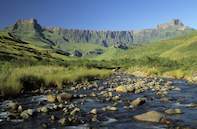
Home to one of the highest waterfalls in the world, KwaZulu Natal's Royal Natal Park is one of the uKhahlamba-Drakensberg's best known features and is renowned for its breath-taking scenery and fantastic hiking trails.
Centred upon the sheer crescent-shaped rock face of the Amphitheatre, the Royal Natal Park extends across 8 000 hectares and is located at the northern most section of the uKhahlamba Drakensberg Mountain Range. The park was given its namein 1947 to commemorate a visit by the British Royal family.
The Largest Amphitheatre in the World
Averaging a height of 2 926 metres, the Amphitheatre's two main landmarks are the glorious waterfall; the Tugela falls, that tumbles a sheer 850 metres and the 3 282 metre Mont-aux-Sources where the Tugela river rises. Mont-aux-source was given its name in 1836 by the missionaries; Arbousset and Daumas who discovered it.The second highest peak, the Sentinel is located to the east of the Amphitheatre and rises to a height of 3 165 metres.
Judging by the abundant rock art in the area, the Royal Natal Mountains have been home to the white settlers and the Nguni farmers and for thousands of years prior to them, the San people. The last San people to live in the Royal Natal vicinity left in approximately 1878.
Driving towards the park into the uThukela River valley, one will be met with the sight of the mighty cliffs of the Amphitheatre looming over you with its thick dolerite capping and lower levels of sandstone, silt and mudstones. The vegetation in the higher and western sections of the park is dominated by grassland, while low heath plants such as small-leaved heath and everlastings are mostly found on the summit. There are no trees in these reaches of the mountain due to the extensive felling of the hardwood trees that occurred in the area from 1884 into the 1930s.
While grassland dominates the park there are sections of fynbos and Afrotemperate forest and one might see examples of the Drakensberg cycad and the Drakensberg protea, which is well adapted to surviving the fires that periodically sweep across the mountain slopes, by having underground stems and large rootstocks. In the wetter regions one will find common tree ferns (some growing up to 5 metres high). White stinkwood, large yellowwoods and other trees also found within the uKhahlamba National Park are found in the forest pockets along these slopes.
What Wildlife can I Expect to See?
The Royal Natal Park is home to 56 species of mammals and has a rich bird life. During the summer months visitors will find Eland along the high grassland regions and Bushbuck and Common Duiker are often seen in the early mornings and late afternoons in the forest and bush regions below 1 900 metres.
Raptors, assorted species of Vultures, Eagles, Buzzards and Kestrels are all found within the mountain range. Rock Hyrax are found wherever there are suitable rock piles and cervices. Savanna Baboons are found throughout the nature reserve and visitors should not feed them or leave food unattended.

 Royal Natal National Park is renowned for its spectacular scenery and fabulous mountain trails which explore the heart of this KwaZulu-Natal...
Royal Natal National Park is renowned for its spectacular scenery and fabulous mountain trails which explore the heart of this KwaZulu-Natal...